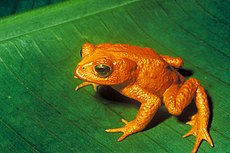
Back Uitgestorwe in die natuur Afrikaans نوع منقرض في البرية Arabic Изчезнал в природата вид Bulgarian বন্য পরিবেশে বিলুপ্ত Bengali/Bangla Extinta en estat salvatge Catalan Taxon vyhynulý v přírodě Czech Uddød i vild tilstand Danish Formortinta en naturo Esperanto Especie extinta en estado silvestre Spanish Looduses välja surnud Estonian
| Conservation status | |
|---|---|
 | |
| Extinct | |
| Threatened | |
| Lower Risk | |
Other categories | |
| (list) | |
Related topics | |
 Comparison of Red List classes above and NatureServe status below  | |


A species that is extinct in the wild (EW) is one that has been categorized by the International Union for Conservation of Nature as only consisting of living members kept in captivity or as a naturalized population outside its historic range.[1][2] Classification requires exhaustive surveys conducted within the species' known habitat with consideration given to seasonality, time of day, and life cycle.[2][3] Once a species is classified as EW, the only way for it to be downgraded[3] is through reintroduction.[3][4]
Not all EW species are rare. An example is the Brugmansia family, where all seven species are widely cultivated, but none are found in the wild.[5] Ultimately, the purpose of preserving biodiversity is to maintain ecological function to prevent ecological extinction.
- ^ "2001 IUCN Red List Categories and Criteria: Version 3.1" (PDF). IUCN. p. 14. Archived from the original (PDF) on 21 June 2010. Retrieved 30 May 2010.
- ^ a b "The IUCN Red List Categories and Criteria". IUCN Red List.
- ^ a b c IUCN. (2003). Guidelines for Application of IUCN Red List Criteria at Regional Levels: Version 3.0. IUCN Species Survival Commission. IUCN, Gland, Switzerland and Cambridge, UK. ii + 26 pp.
- ^ "Reasons for Changing Category". IUCN Red List.
- ^ Petruzzello, Melissa. "Extinct in the Wild but Still Around: 5 Plants and Animals Kept Alive by Humans". Encyclopædia Britannica. Retrieved 16 November 2019.
© MMXXIII Rich X Search. We shall prevail. All rights reserved. Rich X Search